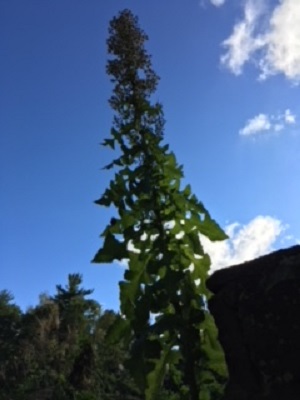
Lactuca serriola
This has been a great year for weeds. Not only have they proliferated like the meaning of the word but some of them have reached an extraordinary size. One that you might have noticed is prickly lettuce (Lactuca serriola). This form of wild lettuce was introduced from Eurasia but now grows wild in every state except Alaska. This plant is quite common and has the ability to grow in some very extraordinary places. It will quite cheerfully grow out of cracks in cement, out of brick walls and in any seam between structures so not only those with available soil will be seeing this one but city dwellers may find it growing in odd spots as well. While it might prefer fertile soil it will grow in any sunny location where the soil has been disturbed. While prickly lettuce is normally found growing at its lower range of 2-3 feet and has soared to its maximum range of 7-8 feet with all of the rain that we have had this year. It is a spectacular plant and hard to overlook. So if you are wondering what that huge plant in your yard is here is how to identify wild lettuce.
The species name serriola describes the leaves. They are saw-toothed much like a dandelion. The size depends on the size of the plant but they can be as long as 12 inches and as wide as 4 inches. They are alternate on the stem and decrease in size as they travel upward. Until the main stem forms the rosette of leaves may be easily mistaken for a dandelion. The main form of identification and what distinguishes it from dandelion, its cousin L. virosa. and other plants with saw-toothed leaves is the prickles on the underside of the leaves. These prickles resemble small hairs on the leaf bottom but along the mid rib they are sharper and very distinctive.
The flowers appear at the top of the stem in loosely arranged terminal clusters. They are yellow, daisy like and less than ½ inch across. Each flower is attached with a small stem. There may be multiple flower clusters as the plant tends to branch at the top. Flower buds are green and tear drop shaped. The fruit is rounded at the bottom and narrow at the top with a tuft at one end. It contains one seed that, when ready for release, has a small puff like a dandelion.
The stems are 2 to 7 feet tall and hollow. There is a leaf at each node and the bottoms of the stem may be prickly. The is only one stem although there may be some minor branching at the top when the flowers appear. The stem is waxy and contains a milky sap. There may be red dots on the stem or reddish areas.. The plant is a biennial and this stem only forms the second year. The first year form is a stemless rosette.
The genus name Lactuca refers to this sap and it is what makes prickly lettuce interesting. An alternate name for the plant is opium lettuce. As far back in written record as ancient Egypt the sap from the plant has been used to relieve pain and for its and narcotic and sedative properties. The active ingredient is lactucarium. It does not have the impact of opium, nor is it addictive. While this compound in not as potent as opium it is not safe to use without consulting a practitioner versed in dosage. There have been documented cases where it has caused hallucinations, severe agitation, vomiting, semi-consciousness and other symptoms. The young shoots are edible and should not contain any of the active ingredient. Again caution is advised, as at least one case of poisoning was reported from ingesting the plant in May. Although it is rare massive doses can cause cardiac paralysis. Another form of wild lettuce L. virosa is by far the more dangerous as it contains a more concentrated form of the sap.
Prickly lettuce is a weed and can become a nuisance like any plant that proliferates in areas in which it is not wanted. It is however an impressive and interesting weed. Keep a lookout for it and if anyone wants to try planting it I have seeds.